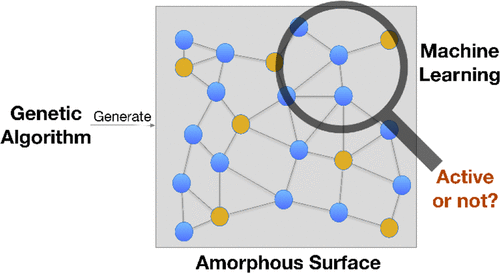Hampered by the huge configuration space, the traditional computational chemistry method, especially ab-initio molecular dynamics (AIMD) could not bridge time gap and space gap, which dramatically limits its application in rational catalyst design. In the past decade, artificial intelligence became increasingly popular and machine learning rode on the crest of this wave. Nascent machine-learning techniques could accurately fit the high-dimensional potential field and the iterative calculation could be exponentially accelerated, whereby the bottleneck of basic DFT calculation processes could be broken through. Recently, we applied deep learning techniques in catalysis. The details are listed as follows:
We developed an on-the-fly training strategy combing the an advanced neural network called SchNet and the genetic algorithm (GA) search technique to rapidly figure out the correlation between configuration and energy of 38-atom Pt-Au cluster, whose accuracy could reach DFT level. Interestingly, the thermodynamically most stable PtmAu38-m cluster is Pt6Au32, with all the core-region sites occupied by Pt.


By virtue of GBDT algorithm and HDNN, we successfully screened out the highly active site of amorphous Ni2P catalyst for HER. Our method decomposes the difficult prediction of adsorption energy on amorphous surfaces into two sub-problems: frozen adsorption energy and relaxation energy. By training with a set of ab-initio adsorption energies within a wide configuration space, we succeed to predict the adsorption energies with ~0.1 eV error by adopting the feature only relying on local chemical environment.
Publications
4. DM Chen; ZZ Lai; JW Zhang; JF Chen; PJ Hu; HF Wang, Gold Segregation Improves Electrocatalytic Activity of Icosahedron Au@Pt Nanocluster: Insights from Machine Learning. Chin. J. Chem. 2021, 39, 3029-3036.
3. J Zhang; J Chen; P Hu; H Wang, Identifying the composition and atomic distribution of Pt-Au bimetallic nanoparticle with machine learning and genetic algorithm. Chinese Chemical Letters 2020, 31 (3), 890-896.
2. J Zhang; P Hu; H Wang, Amorphous Catalysis: Machine Learning Driven High-Throughput Screening of Superior Active Site for Hydrogen Evolution Reaction. The Journal of Physical Chemistry C 2020, 124 (19), 10483-10494.
1. C Zhou; B Zhang; P Hu; HF Wang, An effective structural descriptor to quantify the reactivity of lattice oxygen in CeO2 Subnano-clusters. Physical Chemistry Chemical Physics 2020, 22 (3), 1721-1726.

